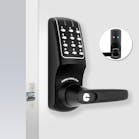Most office furniture locks use disc tumbler construction. Disc tumbler locks are less expensive to manufacture than their pin tumbler counterparts while still allowing the flexibility of masterkeying.
Master keys (MK) are designed to operate every lock in a given code series. By adding additional features to a master key blank, the same key can then be used to remove the lock plug. This removable plug feature is especially important to office furniture dealers. The dealer can sell his customer a wide range of cabinets or desks and then quickly key-alike the locks without removing the lock bodies from each piece of furniture. The dealer only has to stock a quantity of lock plugs to interchange as needed.
Almost every manufacturer of cabinet locks now has some type of removable lock plug system. Most manufacturers add an extra sixth tumbler at the end of the plug. This tumbler acts as the plug retainer during normal usage.
Master keys and operating keys contain five cuts. The removal key (RK) contains six cuts. When the removal key is inserted, the sixth cut lifts the retainer tumbler out of the retainer slot and into the plug. The plug can then be removed for replacement or servicing. As a security measure, the plug can only be removed when in an unlocked position.
There are other plug removal designs. Timberline locks actually remove a small portion of the master key blade tip to form a removal key. The master key tip fits into a socket in the housing for normal operation. By removing a portion of the tip, the removal key is no longer held by the socket. This allows the removal key to rotate slightly further in the housing to a position where the plug can be removed.
The following list shows known master key and removal key information. Master keys are marked (MK); removal keys are marked (RK).
Aftermarket key blanks are often not available in the length required to make some of the keys on the list. The only alternative is to remove material from the top and bottom shoulders in order to lengthen the available blanks as needed. In other cases, the blade must be shortened from five cut length to four cut length.




